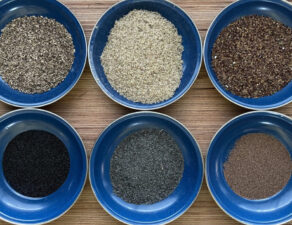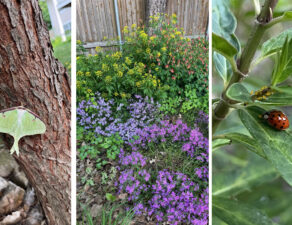
Photo: Fruiting Spicebush (Lindera benzoin), Dr. Nadia Navarrete-Tindall
By: Dr. Nadia Navarrete-Tindall, State Extension Specialist, Lincoln University of Missouri.
Native edible plants can be found in woodlands, grasslands and wetlands, but only a few are consumed regularly. They can provide ingredients to prepare stews, soups, teas, and jams or be consumed fresh, the way Native Americans did before Europeans arrived.
More than 2000 native species grow in Missouri, many of them edible. This article covers only four popular species that can be harvested in the fall for their fruits or leaves.
Many edible native plants are available commercially and could be grown in gardens and farms or used to create living edible hedgerows or windbreaks. At Lincoln University in Jefferson City, many natives are established at the Finca EcoFarm where visitors can see them firsthand.

Photo: Randy Tindall
Spicebush (Lindera benzoin), an aromatic native edible for people and butterflies
Spicebush is a very aromatic plant. The leaves and tiny fruits (berry-like drupes) contain compounds that have a distinct pleasant odor when crushed and contribute flavor to foods and beverages. In fact, that is one way to help identify it. Leaves and twigs can be used for tea, and the bright red fruits are good substitutes for allspice, with a hint of peppercorn flavor. Spicebush is dioecious, which means that the male and female flowers are produced in separate trees.

Photo: Dr. Nadia Navarrete-Tindall
Wild Plums (Prunus spp.) for jellies, syrups and more
According to George Yatskievych in Flora of Missouri, there are five native plum species in Missouri. Four of them —Prunus americana, P. angustifolia, P. hortulana, and P. munsoniana, are found in prairies or open sites as small trees or forming thickets. Mexican plum or P. Mexicana rather forms one stem and has larger fruits. The bright orange to red fruits of all these species mature in late summer and can be harvested from the tree before they are fully matured and set aside at room temperature to fully ripen. The flavor varies from very tart to sweet. Jellies and marmalades made from them have excellent flavor! They can also be used in savory dishes like chutneys and to make wine. To reduce the incidence of diseases in orchards, the trees can be pruned in early spring to allow better air circulation.

Photo: Dr. Nadia Navarrete-Tindall
American persimmon (Diospyros virginiana), from cookies to wine
Persimmon season is here, and the edible fruits are ready to harvest. Despite folklore, you do not have to wait to gather them after the first frost. It may seem a little early but to be sure they are ready to eat, wait until they fall to the ground, show a handsome orange-yellow or dull yellow color and are soft. Based on my own experience, if you pick persimmons from the tree, you may get an unpleasant surprise, because immature persimmons can be very astringent. Once mature, fruits are delicious and can be used to prepare cookies, cakes, puddings, and custards, as well as wine, vinegar, and even beer. To prepare sweet goodies, using persimmons allows the use of less sugar, due to their own sweetness. Most native persimmons are about one inch in diameter, but trees sometimes have larger fruits. Like spicebush, persimmon trees are dioecious.

Photo: Dr. Nadia Navarrete-Tindall
Paw paw (Asimina triloba), a native fruit good for us and zebra swallowtail butterflies
Paw paw is the largest native fruit in the continental United States. Some people call it false banana because the flavor and texture are similar to bananas; however, to me they have their own distinctive flavor. Paw paw belongs to the custard family or Annonaceae, with most members being from tropical regions. Paw paw fruits can be consumed fresh or prepared in bake goods or ice cream. These trees naturally grow in the understory in bottomlands.
You can have your own little supermarket by planting these and other native plants right in your own backyard and beautify your surroundings by creating butterfly corridors. Remember the plants suggested above are just to get you started!
There are many reasons to grow and consume native edible plants. Most, if not all, also offer benefits for pollinators, butterflies and other wildlife, so one can adopt those that offer the most rewards and create your own native edible habitat!
Note: One word of caution is that before you start consuming any native plants, be sure you know how to identify them!
Curious to sample some of these delectables? You may see them on the menus of one of these local restaurants with native edibles supplied by Prairie Birthday Farm:
The Town Company
The Antler Room
Green Dirt on Oak
Torn Label Brewing Co.
Bon Appétit!







